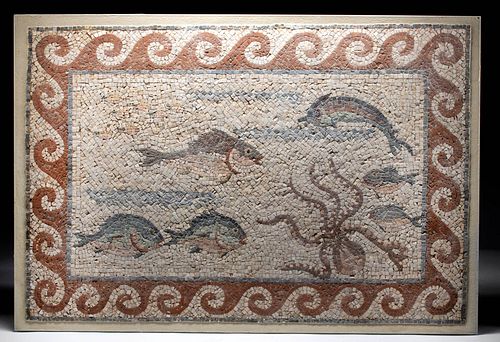Roman Stone Mosaic with Sea Life
Lot 47c
About Seller
Artemis Gallery
686 S Taylor Ave, Ste 106
Louisville, CO 80027
United States
Selling antiquities, ancient and ethnographic art online since 1993, Artemis Gallery specializes in Classical Antiquities (Egyptian, Greek, Roman, Near Eastern), Asian, Pre-Columbian, African / Tribal / Oceanographic art. Our extensive inventory includes pottery, stone, metal, wood, glass and textil...Read more
Categories
Estimate:
$30,000 - $45,000
Absentee vs Live bid
Two ways to bid:
- Leave a max absentee bid and the platform will bid on your behalf up to your maximum bid during the live auction.
- Bid live during the auction and your bids will be submitted real-time to the auctioneer.
Bid Increments
| Price | Bid Increment |
|---|---|
| $0 | $25 |
| $300 | $50 |
| $1,000 | $100 |
| $2,000 | $250 |
| $5,000 | $500 |
| $10,000 | $1,000 |
| $20,000 | $2,500 |
| $50,000 | $5,000 |
| $100,000 | $10,000 |
| $200,000 | $20,000 |
About Auction
By Artemis Gallery
Oct 8, 2020
Set Reminder
2020-10-08 10:00:00
2020-10-08 10:00:00
America/New_York
Bidsquare
Bidsquare : Exceptional Antiquities, Asian, Ethnographic
https://www.bidsquare.com/auctions/artemis-gallery/exceptional-antiquities-asian-ethnographic-5796
Museum-worthy examples of Egyptian, Greek, Roman, Etruscan, Near Eastern, Far East / Asian, Pre-Columbian, African / Tribal,Oceanic, Native American, Spanish Colonial, Russian, Fossils, Ancient Jewelry, Fine Art, so much more! Artemis Gallery info@artemisgallery.com
Museum-worthy examples of Egyptian, Greek, Roman, Etruscan, Near Eastern, Far East / Asian, Pre-Columbian, African / Tribal,Oceanic, Native American, Spanish Colonial, Russian, Fossils, Ancient Jewelry, Fine Art, so much more! Artemis Gallery info@artemisgallery.com
- Lot Description
Roman, Imperial Period, ca. 2nd to 4th century CE. A large sea-themed mosaic panel, skillfully delineated with hundreds of square stone tesserae of sienna, dove grey, charcoal, russet, and cream hues - a very tasteful palette. The composition features from left to right: two fish swimming toward the right of the composition, a multi-legged squid or octopus, a magnificent swordfish above, and two smaller fish swimming toward the left of the composition - all surrounded by a border of stylized waves in russet and cream flanked by grey linear bands. Given the aquatic theme, this piece was likely located in a Roman formal dining room (triclinium). Extravagant feasts played an important role in ancient Roman society; however, some objected to such indulgences. Interestingly, Augustus (27 BCE - 14 CE) enforced laws to put an end to gluttonous menus and excessive spending for such affairs. Nevertheless, these laws could not stop the elite from enjoying lavish meals which oftentimes included delicacies from the sea! Size of mosaic: 42" W x 28" H (106.7 cm x 71.1 cm); Size of frame: 1" L x 44.5" W x 30.5" H (2.5 cm x 113 cm x 77.5 cm)
Mosaics (opus tesellatum) are some of our most enduring images from the Roman world, exciting not only for their aesthetic beauty, but also because they reveal what Romans chose to depict and see every day decorating their private and public spaces. Aquatic and maritime subjects were popular in Greco-Roman art. One of my favorite examples is in the House of the Faun in Pompeii (end of 2nd century BCE, Museo Archeologico Nazionale, Naples). Another from Piazza Armerina, room 22, depicts an entertaining scene of winged Erotes reeling in their catch (4th century CE).
In ancient Rome, fish was generally more coveted than other forms of 'meat'. According to scholar Deborah Ruscillo, "Eating well was not just a daily ritual, it was a philosophy and a way of life in Imperial Rome. Your reputation and acceptance in the upper echelons of society was often determined by your abilities as a generous host and as a connoisseur. " ("When Gluttony Ruled!" Archaeology - a publication of the Archaeological Institute of America, volume 54 number 6, November/December 2001)
Provenance: ex-Phoenicia Holyland Antiquities; acquired from the Liebert family collection, late 1980s
All items legal to buy/sell under U.S. Statute covering cultural patrimony Code 2600, CHAPTER 14, and are guaranteed to be as described or your money back.
A Certificate of Authenticity will accompany all winning bids.
We ship worldwide and handle all shipping in-house for your convenience.
#155498Mounted on plaster with a framed honeycomb backing to make it lighter. All tesserae are original with some small areas of restoration to the mount around the peripheries. Some of the tesserae have small losses, chips, wear, and deposits. Colors are still vibrant and motif very clear!Condition
- Shipping Info
-
All shipping is handled in-house for your convenience. Your invoice from Artemis Gallery will include shipping calculation instructions. If in doubt, please inquire BEFORE bidding for estimated shipping costs for individual items.
-
- Buyer's Premium



 EUR
EUR CAD
CAD AUD
AUD GBP
GBP MXN
MXN HKD
HKD CNY
CNY MYR
MYR SEK
SEK SGD
SGD CHF
CHF THB
THB















